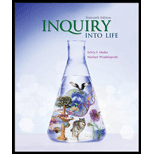
Inquiry Into Life (16th Edition)
16th Edition
ISBN: 9781260231700
Author: Sylvia S. Mader, Michael Windelspecht
Publisher: McGraw Hill Education
expand_more
expand_more
format_list_bulleted
Textbook Question
Chapter 14.2, Problem 1LO
Summarize the major functions of the pancreas, the liver, and the gallbladder.
Expert Solution & Answer
Want to see the full answer?
Check out a sample textbook solution
Students have asked these similar questions
please fill in the empty sports,
thank you!
In one paragraph show how atoms and they're structure are related to the structure of dna and proteins. Talk about what atoms are. what they're made of, why chemical bonding is important to DNA?
What are the structure and properties of atoms and chemical bonds (especially how they relate to DNA and proteins).
Chapter 14 Solutions
Inquiry Into Life (16th Edition)
Ch. 14.1 - Prob. 1LOCh. 14.1 - Prob. 2LOCh. 14.1 - Prob. 3LOCh. 14.1 - Prob. 1CYPCh. 14.1 - Compare the major functions of the small intestine...Ch. 14.1 - Discuss strategies that might help obese people...Ch. 14.2 - Summarize the major functions of the pancreas, the...Ch. 14.2 - Prob. 2LOCh. 14.2 - Review what it means to say that the pancreas has...Ch. 14.2 - Prob. 2CYP
Ch. 14.2 - Prob. 3CYPCh. 14.3 - Prob. 1LOCh. 14.3 - Compare the specific types of chemical digestion...Ch. 14.3 - Prob. 1CYPCh. 14.3 - Prob. 2CYPCh. 14.3 - Prob. 3CYPCh. 14.4 - Prob. 1LOCh. 14.4 - Describe the relationship between diet and...Ch. 14.4 - Prob. 3LOCh. 14.4 - Prob. 1QTCCh. 14.4 - Prob. 1CYPCh. 14.4 - Prob. 2CYPCh. 14.4 - Prob. 3CYPCh. 14.4 - Describe how a dietary supplement may be harmful...Ch. 14.5 - Describe the three main categories of eating...Ch. 14.5 - Prob. 2LOCh. 14.5 - Distinguish between compulsive eating, binge...Ch. 14.5 - Prob. 1CYPCh. 14.5 - Predict some physiological factors that could...Ch. 14.6 - Describe a common disorder that affects each part...Ch. 14.6 - Classify the digestive disorders by the type of...Ch. 14.6 - What kinds of adaptations would H. pylori need in...Ch. 14.6 - Why do you suppose that even after Dr. Marshall's...Ch. 14.6 - Prob. 3QTCCh. 14.6 - Identify the specific cause of most stomach...Ch. 14.6 - Explain why the pancreas and liver are such...Ch. 14 - Prob. C2BYBCh. 14 - Chapter 7 By what specific biochemical processes...Ch. 14 - Prob. S11.5BYBCh. 14 - Prob. 1ACh. 14 - Prob. 2ACh. 14 - Prob. 3ACh. 14 - Prob. 4ACh. 14 - Prob. 5ACh. 14 - Prob. 6ACh. 14 - Prob. 7ACh. 14 - Prob. 8ACh. 14 - Prob. 9ACh. 14 - Prob. 10ACh. 14 - Prob. 11ACh. 14 - Prob. 12ACh. 14 - Prob. 13ACh. 14 - Prob. 14ACh. 14 - Prob. 15ACh. 14 - Prob. 16ACh. 14 - Prob. 17ACh. 14 - Prob. 1TCCh. 14 - Suppose you are taking large doses of creatine, an...Ch. 14 - Prob. 3TC
Knowledge Booster
Learn more about
Need a deep-dive on the concept behind this application? Look no further. Learn more about this topic, biology and related others by exploring similar questions and additional content below.Similar questions
- The Sentinel Cell: Nature’s Answer to Cancer?arrow_forwardMolecular Biology Question You are working to characterize a novel protein in mice. Analysis shows that high levels of the primary transcript that codes for this protein are found in tissue from the brain, muscle, liver, and pancreas. However, an antibody that recognizes the C-terminal portion of the protein indicates that the protein is present in brain, muscle, and liver, but not in the pancreas. What is the most likely explanation for this result?arrow_forwardMolecular Biology Explain/discuss how “slow stop” and “quick/fast stop” mutants wereused to identify different protein involved in DNA replication in E. coli.arrow_forward
- Molecular Biology Question A gene that codes for a protein was removed from a eukaryotic cell and inserted into a prokaryotic cell. Although the gene was successfully transcribed and translated, it produced a different protein than it produced in the eukaryotic cell. What is the most likely explanation?arrow_forwardMolecular Biology LIST three characteristics of origins of replicationarrow_forwardMolecular Biology Question Please help. Thank you For E coli DNA polymerase III, give the structure and function of the b-clamp sub-complex. Describe how the structure of this sub-complex is important for it’s function.arrow_forward
- Molecular Biology LIST three characteristics of DNA Polymerasesarrow_forwardMolecular Biology RNA polymerase core enzyme structure contains what subunits? To form holo enzyme, sigma factor is added to core. What is the name of the structure formed? Give the detailed structure of sigma factor and the function of eachdomain. Please help. Thank youarrow_forwardMolecular Biology You have a single bacterial cell whose DNA is labelled with radioactiveC14. After 5 rounds of cell division, how may cells will contain radioactive DNA? Please help. Thank youarrow_forward
- 1. Explain the structure and properties of atoms and chemical bonds (especially how they relate to DNA and proteins). Also add some pictures.arrow_forward1. In the Sentinel Cell DNA integrity is preserved through nanoscopic helicase-coordinated repair, while lipids in the membrane are fortified to resist environmental mutagens. also provide pictures for this question.arrow_forwardExplain the structure and properties of atoms and chemical bonds (especially how they relate to DNA and proteins). Also add some pictures.arrow_forward
arrow_back_ios
SEE MORE QUESTIONS
arrow_forward_ios
Recommended textbooks for you
 Human Biology (MindTap Course List)BiologyISBN:9781305112100Author:Cecie Starr, Beverly McMillanPublisher:Cengage Learning
Human Biology (MindTap Course List)BiologyISBN:9781305112100Author:Cecie Starr, Beverly McMillanPublisher:Cengage Learning Human Physiology: From Cells to Systems (MindTap ...BiologyISBN:9781285866932Author:Lauralee SherwoodPublisher:Cengage LearningEssentials of Pharmacology for Health ProfessionsNursingISBN:9781305441620Author:WOODROWPublisher:Cengage
Human Physiology: From Cells to Systems (MindTap ...BiologyISBN:9781285866932Author:Lauralee SherwoodPublisher:Cengage LearningEssentials of Pharmacology for Health ProfessionsNursingISBN:9781305441620Author:WOODROWPublisher:Cengage Fundamentals of Sectional Anatomy: An Imaging App...BiologyISBN:9781133960867Author:Denise L. LazoPublisher:Cengage Learning
Fundamentals of Sectional Anatomy: An Imaging App...BiologyISBN:9781133960867Author:Denise L. LazoPublisher:Cengage Learning

Human Biology (MindTap Course List)
Biology
ISBN:9781305112100
Author:Cecie Starr, Beverly McMillan
Publisher:Cengage Learning

Human Physiology: From Cells to Systems (MindTap ...
Biology
ISBN:9781285866932
Author:Lauralee Sherwood
Publisher:Cengage Learning

Essentials of Pharmacology for Health Professions
Nursing
ISBN:9781305441620
Author:WOODROW
Publisher:Cengage

Fundamentals of Sectional Anatomy: An Imaging App...
Biology
ISBN:9781133960867
Author:Denise L. Lazo
Publisher:Cengage Learning


Human digestive system - How it works! (Animation); Author: Thomas Schwenke;https://www.youtube.com/watch?v=X3TAROotFfM;License: Standard Youtube License